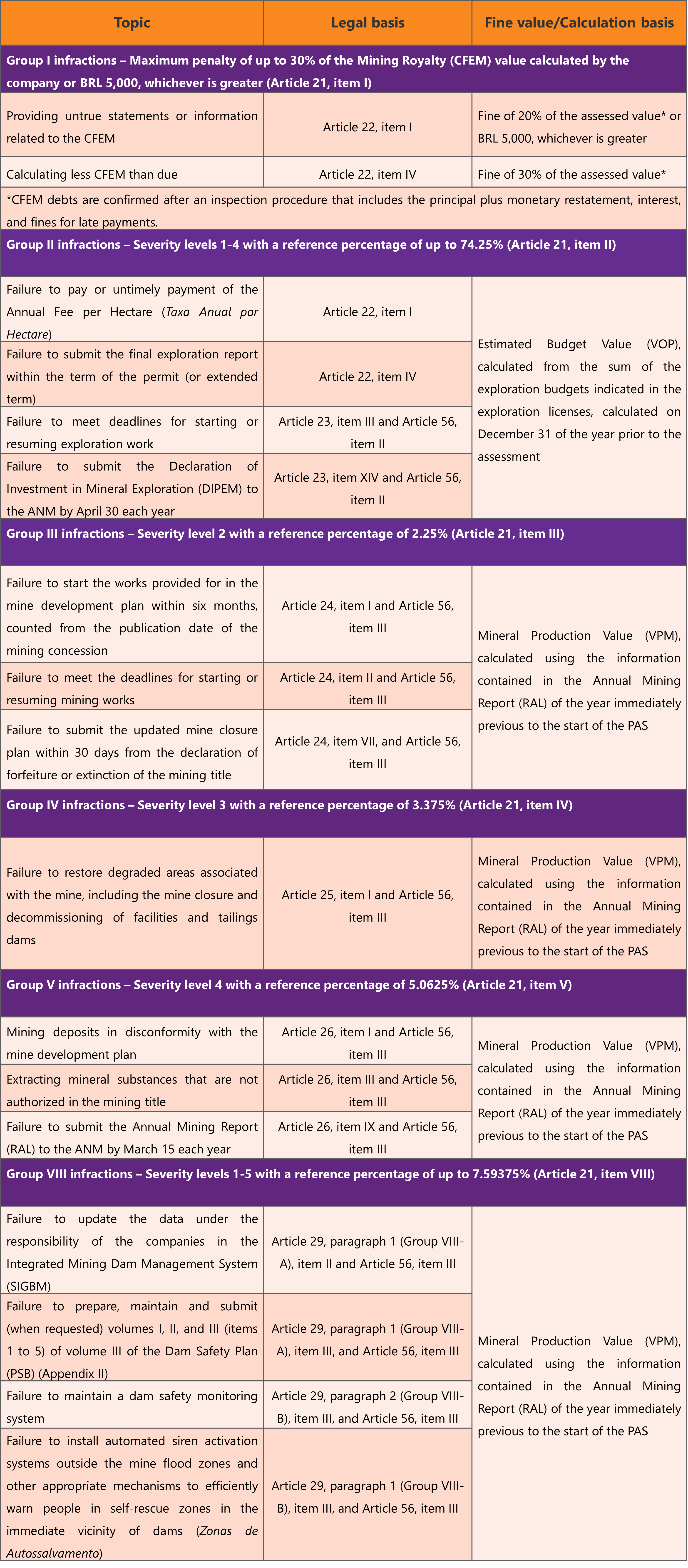

Brazilian Mining Agency regulates administrative sanctioning process
New resolution introduces procedures to determine non-compliance and establishes new penalties and increased fines
Subjects
Published in the Federal Official Gazette on December 1, 2022, the Brazilian Mining Agency’s (ANM) Resolution No. 122/2022 regulates procedures regarding infractions, sanctions, and penalties for entities that fail to comply with Brazilian mining legislation. The resolution was unanimously approved by the ANM Collegiate Board at its 24th Extraordinary Meeting on November 28, 2022.
The new regulation took effect on the date it was published. However, it also applies to procedural aspects of ongoing administrative proceedings.
Overview
The new resolution stems from Law No. 14,066/2020, which amended provisions of Brazil’s Mining Code (Decree-Law No. 227/1967). The changes included new circumstances for handing down sanctions and fines of up to BRL 1 billion, depending on the severity of the infraction. Prior to these changes, the financial penalties provided for in the mining legislation were very lenient and in need of revision.
Published in February 2022, Decree No. 10,965 amended Article 52 of the Mining Code Regulation (Decree No. 9,406/2018), determining that the ANM should provide for sanctions and set the value of fines for breaches of the Mining Code. The decree also established a 180-day time limit for the agency to issue such a resolution.
Despite the ANM’s efforts, this initially established deadline was too short. As such, on September 15, 2022, Decree No. 11,197 amended the wording of the Mining Code Regulation set by Decree No. 10,965/2022, determining that changes provided for in Article 52 would only come into effect on November 30, 2022.
In practice, the ANM began working on the draft resolution in February 2022 (when Decree No. 10,965/2022 was published). However, it only made the draft available for public consultation and contributions about a month before the ANM Collegiate Board voted to approve it, bypassing essential steps in the drafting process. This has led to criticism of the process as a whole, as will be explained in further detail below.
The resolution
ANM Resolution No. 122/2022 regulates the following topics:
- Penalties for mining activity infractions, organizing them into eight groups based on their nature and five levels of severity;
- Preliminary measures that the authorities may adopt, such as shutting down or interrupting mining operations if risks are identified; and
- Investigations of infractions through the Administrative Sanctioning Process (PAS), guaranteeing the regulated party the right to respond and defend itself in court.
Furthermore, the resolution sets the parameters for calculating fines between BRL 2,000 and BRL 1 billion, as provided for in the Mining Code since it was amended in 2020.
Article 6 of the Resolution No. 122/2022 has sought to consolidate 12 different types of penalties for failing to comply with mining sector legislation, namely:
- Warnings;
- One-time fines;
- Invalidation of mining titles;
- Ex-officio invalidation of exploration permits;
- Cancelation of mining titles;
- Daily fines;
- Temporary, partial or total suspension of mining activities;
- Seizures of ores, goods and equipment;
- Mine or mining activity embargoes;
- Demolitions of mine infrastructure;
- Interdictions;
- Restrictions on rights.
The ANM must first instigate the PAS before these penalties can be applied, either at its own initiative or in response to third-party representations or communications. The company (or individual) involved will be notified of all actions linked to the PAS, particularly the issuance of the infraction notice, and will be assured the opportunity to defend itself.
The resolution establishes a period of 20 days to present a defense or an appeal (from the date the company is notified of the infraction or of the ANM’s decision), as the case may be. Within the same period, parties also have the opportunity to acknowledge they committed the violation and waive their right to appeal. In such cases, financial penalties will be reduced by 60%.
Financial penalties
The table below highlights financial penalties for certain relevant infractions:
 The resolution provides for the multiples by which fines should be calculated (according to the severity of the infraction). There are five severity levels for Group II infractions and five for Group III to Group VIII infractions, so the more serious the infraction committed, the more severe the penalty. The resolution also contains a set of annexes that consolidate the numerous infractions provided for in mining sector regulations – a total of approximately 1,200.
The resolution provides for the multiples by which fines should be calculated (according to the severity of the infraction). There are five severity levels for Group II infractions and five for Group III to Group VIII infractions, so the more serious the infraction committed, the more severe the penalty. The resolution also contains a set of annexes that consolidate the numerous infractions provided for in mining sector regulations – a total of approximately 1,200.
The system linking fine values to generic parameters (such as the Estimated Budget Value (VOP) for all mineral exploration areas of a company or the total Mineral Production Value (VPM) of a company) has stirred doubts about its reasonableness and proportionality. This is especially true for fines applicable to less severe conducts, such as delays in presenting documents or paying the Annual Fee per Hectare. It is expected that the ANM will review this system in the near future to avoid the chance of disproportionate penalties that could ultimately affect investments in exploration and mining.
Issues with the drafting process
ANM Resolution No. 122/2022 has sought to unify and define the sanctions applicable to mining legislation infractions more precisely. Indeed, a resolution for such a purpose was certainly needed.
However, this resolution seems to have raised many concerns for mining companies. By adopting subjective criteria for sanctions and fines that are potentially over-the-top in relation to the value of the obligation that should have been fulfilled, the ANM may have given rise to gravely disproportionate and unreasonable situations. Had the drafting process for the resolution been properly followed, this could have been avoided.
The resolution’s drafting process has already been met with severe criticism from the mining sector, which could weaken the resolution itself. Despite a general consensus that the fines needed to be revised, the new parameters for calculating fines have the potential to generate fines that are totally disproportionate to the nature of the infraction.
The outlook appears even worse when considering recidivism and other aggravating factors, so much so that the resolution itself has established an ‘adaptation period’. As such, the calculation bases for sanctions with severity levels between one and four are reduced by 60% until May 31, 2023, so companies in the mining sector can adapt to the new rules. The resolution also provides for the ANM Collegiate Board to reassess it by May 1, 2024 – demonstrating that the current form of the resolution may be merely transient in nature.
Furthermore, the ANM did not carry out a regulatory impact analysis (RIA), an instrument required by Law No. 13,848/2019. When combined with effective public consultation, an RIA would allow for the resolution to be adequately discussed, given the different possibilities for regulating the topic. However, this did not play out in practice, as there was only one public hearing, with a few subsequent days for contributions from interested parties.
If, as suggested, the ANM was founded to improve the institutionalization of the mining sector, it should observe all stages of the drafting process. This way, adequate and effective resolutions resulting from dialogue with the mining sector and society in general can be conceived, and rules that are disproportionate or disconnected from the dynamics of the sector can be avoided.
For further information on mining regulations, please contact Mattos Filho’s Infrastructure & Energy practice area.


